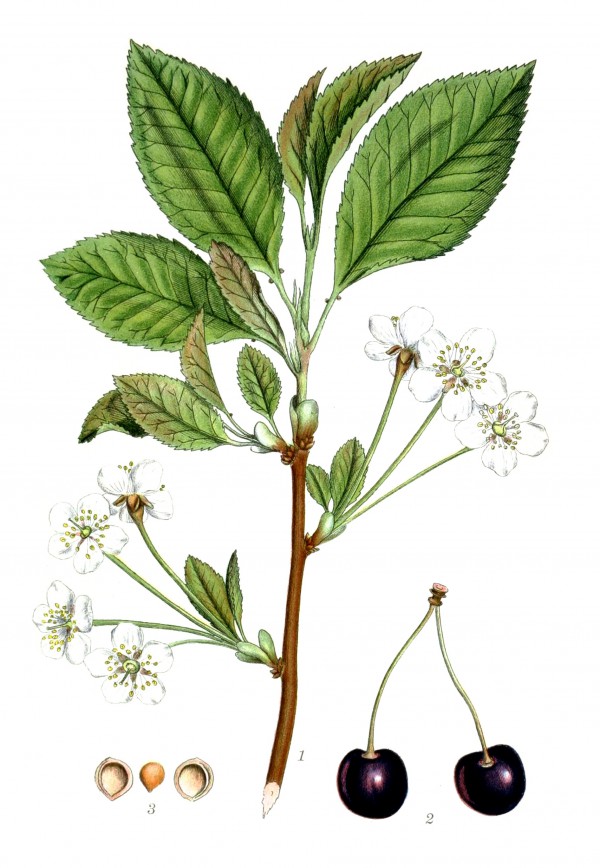Prunus avium (L.) L. - syn.Cerasus avium (L.) Moench - Rosaceae - wild cherry, sweet cherry, bird cherry, Süßkirsche
„The name „wild cherry“ is also commonly applied to other species of Prunus growing in their native habitats, particularly to the North American species Prunus serotina. Prunus avium means „bird cherry“ in the Latin language. In English „bird cherry“ often refers to Prunus padus.“ http://en.wikipedia.org/wiki/Prunus_avium
„Enzymatically labile cyanide is found in all aerial parts of Prunus avium. D-mandelonitrile-β-glucoside (prunasin), identified by GLC occurs in the vegetative parts (except the wood of twigs). Prunasin and d-mandelonitrile-β-gentiobioside (amygdalin) are found in the generative parts.“
[Zur Cyanogenese von Prunus avium., Nahrstedt, A., Phytochemistry, Vol.11(11), 1972, 3121-3126]
„The analysis results for seven of the aroma compounds obtained by vacuum distillation from sweet and sour cherry products were compared. The freshly pressed juices from 5 varieties of sour and 5 varieties of sweet cherries showed great differences in concentrations (μg/L): benzaldehyde (18-393), linalool (0.5-1.7), hexanal (0.3-54.7), 2(E)-hexenal (2.4-220), (E,Z)-2,6-nonadienal (0.1-2.4), phenylacetaldehyde (2.1-5.6) and eugenol (1.0-22.2). The benzaldehyde content of the juices showed the highest correlation to the recognition threshold of the cherry aroma note. The cherry jam showed a drastic change in the aroma composition: benzaldehyde and linalool increased greatly (7 and 13-times, respectively), while hexanal, 2(E)-hexenal and phenylacetaldehyde strongly decreased. The increase in benzaldehyde and linalool, which was also observed during simultaneous distillation/extraction of the juices, is caused by the hydrolysis of the corresponding glycosides during the heat treatments.“
[Quantitative analyse flüchtiger Aromastoffe mit hohen Aromawerten in Sauerkirschen (Prunus cerasus L.), Süßkirschen (Prunus avium L.) und Kirschkonfitüren., Schmid, W., Grosch, W., Zeitschrift für Lebensmittel-Untersuchung und Forschung, Vol.183(1), 1986, 39-44]
„(E)-2-Hexenol, benzaldehyde, hexanal, and (E)-2-hexenal were predominant flavor volatiles and could be used to segregate commercial and new cherry selections into various subgroups.“
[Physicochemical Characteristics of Selected Sweet Cherry Cultivars. B. Girard, T. G. Kopp, J. Agric. Food Chem., 1998, 46 (2), 471–476]
„In the present study, HS–SPME using DVB/CAR/PDMS fibre was employed to extract the volatiles in ‘Lapins’, ‘Rainier’, ‘Stella’, ‘Hongdeng’ and ‘Zhifuhong’. A total of 52 compounds were identified in five cherries on DB-wax and DB-5 columns. Of these, hexanal, (E)-2-hexenal, 1-hexanol, (E)-2-hexen-1-ol, benzaldehyde and benzyl alcohol were the main volatile compounds, according to their high comcentrations in five cherries.
A combination of HS-SPME and GC-O dilution analysis techniques provided a satisfactory assessment of the most volatile compounds that play a major role in odour perception. Hexanal, (E)-2-hexenal, (Z)-3-hexenal, nonanal, geranylacetone, benzaldehyde and benzyl alcohol were the most important aroma-active compounds in all five cherry samples. In addition, acetaldehyde, 3-methylbutanal, octanal, (E)-2-octenal, (Z)-3-hexen-1-ol, decanal, β-phenylacetaldehyde, (E,E)-2,4-nonadienal, methyl salicylate, 1-octen-3-ol, linalool and (E,Z)-2,6-nonadienal were also the important aroma compounds in certain cherry cultivars.“
[Characterization of the aroma-active compounds in five sweet cherry cultivars grown in Yantai (China). Shu Yang Sun, Wen Guang Jiang, Yu Ping Zhao, Flavour and Fragrance Journal, Vol.25 (4), 206-213, 2010] http://onlinelibrary.wiley.com/doi/10.1002/ffj.1994/full
„This paper reports the occurrence of both free and glycosidically bound aroma compounds in three sweet cherry cultivars (‘Hongdeng’, ‘Hongyan’ and ‘Rainier’), with 97 compounds being identified in the three cultivars. The major free volatile compounds found were hexanal, (E)-2-hexenal, (E)-2-hexen-1-ol, benzyl alcohol and benzaldehyde. The major bound volatile compounds found were benzyl alcohol, geraniol, 2-phenylethanol. Also 4-vinylphenol was found in cherry fruit for the first time, and has a relatively high concentration of the glycosidically-bound form in ‘Rainier’… six odour-active free volatiles with OAVs higher than 20 in cherry were hexanal, (E)-2-hexenal, decanal, (E,Z)-2,6-nonadienal, (E,E)-2,4-nonadienal, (E)-β-ionone. Other odourants with relatively high OAVs were (E)-2-nonenal, nonanal, (E,E)-2,4-hexadienal, octanal, methyl benzoate, phenylacetaldehyde, linalool, eugenol, 1-octen-3-ol and (E)-2-octenal. All of the above volatiles are likely to significantly contribute to cherry aroma. For bound volatiles, decanal had the highest OAV (110-181) followed by geraniol, nonanal, octanal, eugenol, 4-vinylphenol and linalool.“
[Free and glycosidically bound aroma compounds in cherry (Prunus avium L.), Ya-Qin Wen, Fei He, Bao-Qing Zhu, Yi-Bin Lan, Qiu-Hong Pan, Chun-You Li, Malcolm J. Reeves, Jun Wang, Food Chemistry, 01/2014; 152: 29-36]
„The volatile organic compounds (VOCs) of the sweet cherry flowers of four cultivars (Brooks, Black Pearl, Tieton and Summit) were identified via headspace solid phase microextraction (SPME) and gas chromatography–mass spectrometry (GC–MS)… Ethanol, linalool, lilac alcohol, acetaldehyde, (E)-2-hexenal, benzaldehyde and dimethyl sulfide were the major volatiles, which were mainly responsible for the characteristic aroma of sweet cherry flowers.“
Another interesting components were aldehydes like nonanal, methional, lilac aldehydes, anisaldehyde (0.4-1.5%), as well as e.g. phenylethanol (0.3-1%), coumarin and vanillin.
[Zhang, Huimin, et al. „Identification of VOCs in essential oils extracted using ultrasound-and microwave-assisted methods from sweet cherry flower.“ Scientific Reports 11.1: 1-13 (2021)]
https://www.nature.com/articles/s41598-020-80891-0

Lindman, C.A.M., Bilder ur Nordens Flora, vol.2, t.314 (1922-1926)
http://plantgenera.org/illustration.php?id_illustration=131570
Prunus avium
© Rolf Marschner (2006),
www.botanische-spaziergaenge.at



